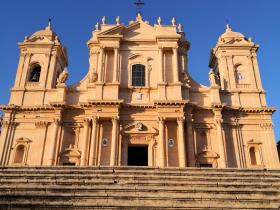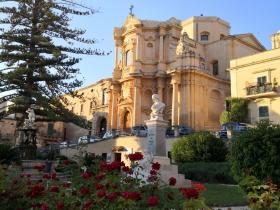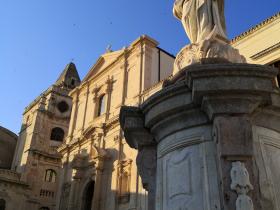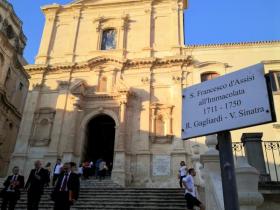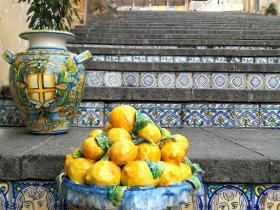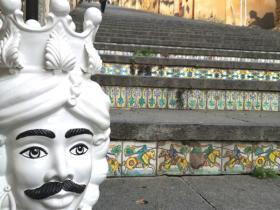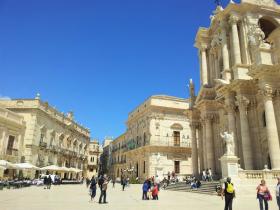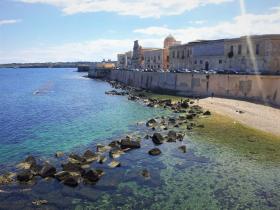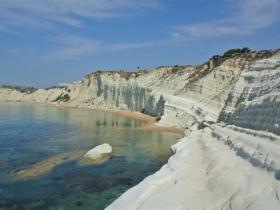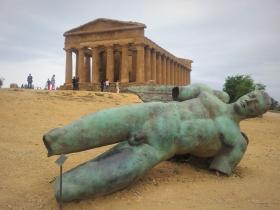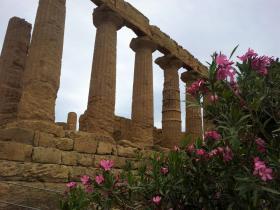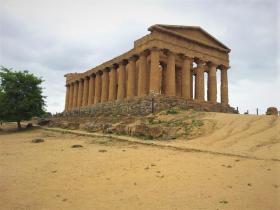B&B Terrazza dei Sogni - Ragusa Ibla
Other Cities
South East Sicily
After the catastrophic earthquake of 1693 the city centre got a new baroque style that can be admired today.
Syracusa is partially expanded in the island of Ortigia and on the mainland. The island is pleanty of ancient nobiliar Palaces and a labyrinth of narrow streets with sea view make this place unique.
Syracusa is considered one of the most important European art city and of course is in the list of the UNESCO .
Apollodium (Apollo’s temple), the oldest Doric temple of Sicily, from the 6th century AD located at the entrance of Ortigia.
This square is an architectural gem, magnific to visit during the day and sunset.
The Duomo, this religious building is located in the northen part of the island. The particularity of this incredible place is that it was built on the ancient foundation of an old doric temple which can be admired inside. This is the symbol of the city.
In the square of Piazza Duomo there are other elegant buildings like the church of Santa Lucia alla Badia with a beautiful baroque facada meanwhile the gate and balcony are made in wrought iron.
From Piazza Duomo with a short and relax walk are easy to reach Fonte Aretusa, a suggestive old Spring with his water coming out from a a cave. The nice garden of Villa Aretusa and the regional gallery of Palazzo Bellomo, which looks after Annunciazione of Antonello da Messina.
Syracusa is an ecletic city, in fact you can also enjoy the clear water of the lungomare Alfeo and get to one of the most beautiful caste of Sicily. Nearby, the archeological park Neapolis is an open space museum with Greek-Roman architectures. Il add, cannot be missed the Greek theatre, Roman amphitheater and Dionisio’s ear.
Nice to visit is the “Museo Aretuso dei Pupi” a mix of Sicilian tradition.
At approximately 50 Km from Ragusa Ibla, arises the town of Noto, an UNESCO Heritage site. After the devastating earthquake of 1693 the town was entirely ruibuilt in Baroque style and relocated into a different area. Centre of the city is The Town Hall Square where stands the Cathedral of San Nicola and Corrado and Ducezio’s Palace which houses the town hall’s institution. Numerous are the baroque buildings which deserve particular admiration along Corso Vittorio Emanuele. Least but no last the magical “Infiorata”, a welcoming ceremony of Spring but also a tribute to flowers used as medium of artworks all along the streets of the city centre. Very importanti to visiti s also The Civil Museum of Noto which holds several archeological findings.
Finally, reaching XVI Maggio Square, stands Villetta D’Ercole where there are two important neighbouring buildings ;The Theatre and The Church of San Domenico both considered masterpieces of the 18th Century.
CALTAGIRONE
Caltagirone is a town located between the central area and the East coast of Sicily and 60 km distant from Ragusa , it is renowned for the production of ceramic which dates back to the Greek domination (Magna Grecia).
In 2002 the historical city centre began to be part of the UNESCO Heritage sites along with the Noto Valley.
Thanks to its particular structure Caltagirone is one of the most popular and interesting sicilian destinations.
WHAT TO SEE
Caltagirone steps or Santa Maria Del Monte was built in 1608 to link the upper and the lower parts of the town. The peculiarity are the steps themselves which were made in basalt and each of them decorated with hand-made ceramic tiles. On this steps are often arranged markets and other events . Ultimately, the steps, lead to the Cathedral of Santa Maria Del Monte which has a meaningful particular that represents the history of the inhabitants; the Altavilla Bell which was stolen from Muslims of Judica.
Caltagirone being one of the eldest towns in Sicily ,has a wide historical background. In fact, there are two main museums to visit; the Ceramic Museum where the 5,000 year history of caramic is thoroghly explained , and the Civil Museum which houses prehistorical rests , Greek-Roman coins and medieval statues.
The Church of San Pietro built in gothic style has a majestic bronzed portal and in each side two bell towers plated with ceramic tiles.
By the sides of the main street (Via Roma) other historical buildings can be admired such as; San Francesco d’Assisi’s Church rebuilt after the 1693 earthquake and added gothic features to it, of which dome was never completed. Il Ponte di San Francesco (Bridge) also embellished with the traditional hand-made tiles was built to bond the two parts of the town.
In conclusion, Via Roma leads to Umberto I Square where arises The Cathedral which was also reconstructed after the earthquake.
PIAZZA ARMERINA
Piazza Armerina is a town located 65 km north-east from Ragusa. It is very well known place for its Roman mosaics, characteristic suburbs made of nets of alleys and the baroque buildings such as; Trigona Palace and the Aragonese Castle. Piazza Armerina has four medieval suburbs where every year several events take place like The Vessillo della Patrona (Maria SS Delle Vittorie) an historycal rievocation of the Normand horse race held, in August.
Agrigento is located in the western coast of Sicily and 120 km away from Ragusa. The history of this amazing town goes back to the Greeks, founders of this particular area. Mainly renowned for the Temples Valley, an Unesco World Heritage site since 1997. The town of Agrigento is a living example of the grandeur of the Greek Empire (Magna Grecia) in Sicily.
Stunning is the view from elevated ground of the Valley from which is possible to sight the deep blue of the Mediterrenean sea at the background and the pictureque blossoms of almond trees.
Amongst the numerous churches to visit in Agrigento there is the church of San Francesco di Paola constructed in 1789 on which ceiling is portrayed the Saint himself along with the Virgin Mary and Jesus Christ holdind the cross, above all the Eternal Father.
The Cathedral of San Gerlando (Patron of the Town) is considered the main place of worship of the entire town. Unique is the Bell Tower that presents Gothic, Catalan and Arab-Norman features .It took over 200 year to finally complete this church of which construction had started around 1100.
The church of Santa Maria Dei Greci, which was one of the first Christian buildings after the Muslim domination. Built on the columns of a Greek temple. Before entering in the church stands a magnific portal with the coat of arm of the powerful Pujades family dating back the 15th century.
The Regional Archaeological Museum is one of the most visited museums in Sicily enstablished in 1960. Inside there are mainly Greek founds and related things, like the Agora and the Monastery.
The Museo Diocesiano, founded in 1873, is inside the building of the residence of the Archbishop , entirely dedicated to the history of Agrigentinean Church from the XII to XIX Century.
Chiaramonte Gulfi is a village of 8.000 inhabitant 18km far from Ragusa. It was founded by the Greek-Syracusan (in the name of Arkillae) but soon it was destroyed by the Arabs. Built again (getting the name of Gulfi) and devastated by the Angevins. Finally by Manfredi Chiaramonte, who erected the city again, Chiaramonte that is the new name, became part of the “Contea of Modica” until the 1693’ s earthquake which razed it to ground. Afterwards, in 1881 the city got is actual name Chiaramonte Gulfi by Regio Decreto in memory of the old name.
The road which goes from Ragusa to Chiaramonte Gulfi is immersed in the countryside, where is easy to see many farms called “Masserie” divided by the old stone walls “Muri a secco”. Built, stone by stone, this is a real art for your eyes.
Most of the commercial activities in town are related to the agriculture, in particular to the oil farming, in fact is still possible to see the old olive-press “trappeti” in the fields. From these a great olive oil DOP can be bought in the numerous shops and farms.
Chiaramonte Gulfi is also considered the “balcony of Sicily” due to the wonderful view of the Etna, MontiIblei, golf of Gela and Caltagirone that can be admired from different sites. Nearby, is also worth to make a stop at the pine grove which is a nice and quite place specially for families with kids as there are animals.
